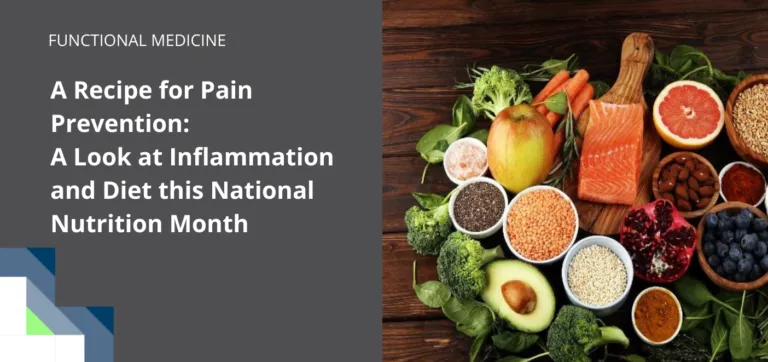A Recipe for Pain Prevention: A Look at Inflammation and Diet this National Nutrition Month

This National Nutrition Month the wise adage of ancient Greek physician Hippocrates, “Let food be thy medicine and medicine be thy food,” will accent health headlines and periodical pages from coast to coast. While scholars note that this oft-quoted phrase is most likely a historical misquotation—it doesn’t actually appear in documents attributed to Hippocrates—the saying is an important nod to the philosophy that nutrition has the power to heal.

Today, compelling connections between diet and chronic disease—diet’s capacity to both prevent and contribute to disease—have inspired a healthy living renaissance. Yet, even amid this wave of health consciousness, the U.S. Department of Agriculture reports that more than 70% of American adults are overweight or obese, and that 6 in 10 American adults live with one or more diet-related chronic diseases.
The link between nutrition and chronic conditions (e.g., obesity, type 2 diabetes
, and cardiovascular disease) traditionally associated with unhealthy choices has long been established. Recent scientific research is deepening our understanding of the intimate link between diet and disease—with findings revealing the significant impact nutrition has on preventing and treating the most serious conditions including chronic and acute pain.
Inflammation Ignition
A culprit of chronic and acute pain, inflammation
is a catch-22. Acute inflammation—an immune response that heals injuries and fights infection—is vital and necessary. However, chronic inflammation—inflammation that lasts for months or even years in healthy tissues—can be devastating. Typically, once the body has healed an injury or fought off an infection, the immune system’s inflammatory response ceases. However, sometimes, the immune system remains in inflammatory mode even after a crisis has passed. This long-lasting inflammation can damage healthy cells and organs, and can cause persistent pain in muscles, tissues, and joints. Chronic inflammation also is linked to many serious diseases and conditions including but not limited to cancer, heart disease, diabetes, depression, arthritis, and Alzheimer’s disease.
Inflammation Influencers
Remarkably, our diet has the ability to stimulate and sedate the inflammatory cycle. A healthy diet supports the proper function of the immune system—allowing it to “turn on” and “turn off” at the appropriate times. Conversely, an unhealthy diet can alter the immune system—causing it to malfunction and protract inflammation.
“Inflammation occurs when there is damage to the tissues from toxic compounds found in a variety of foods, mainly processed foods,” says Health Coach Kendra Eisenbraun of Anodyne’s Pain & Wellness Solutions Clinic in St. George, Utah. Many pro-inflammatory foods—those increasing chronic inflammation—are mainstays in the standard American diet, which is characterized by the consumption of refined grains, trans fats, and high fructose sugars. While research is ongoing, some studies have found that our immune system responds to poor nutrition (e.g., deficiencies in micronutrients such as folic acid, zinc, selenium, iron, and vitamins A, B6, C, and E) much the same way it responds to infection—triggering inflammation.
There also is well-founded scientific evidence that whole grains, nuts, legumes, dark green leafy vegetables, and whole fruits (especially berries)—centerpieces of the Mediterranean diet—areeffective in controlling pain-inducing inflammation. These foods provide the body with important anti-inflammatory nutrients such as antioxidants, omega 3 fatty acids, polyphenols, prebiotics, and probiotics.
When it comes to integrating these healthy, anti-inflammatory foods into our diet, variety is key, says Eisenbraun, who also notes that an anti-inflammatory diet represents one piece of a comprehensive, integrated approach to pain management.
Inflammation Insights
Eisenbraun says that while inflammation is a common root cause of pain, the way inflammation presents in patients can vary greatly—underscoring the value of individualized patient care. “Each patient may experience different symptoms due to inflammation in different areas of the body,” explains Eisenbraun. “Headaches, weight-gain, fatigue, loss of energy, muscle stiffness, pain, and bloat can all be signs of inflammation. This is why individualized care is so important; not one patient is the same.”
To learn more about Anodyne’s patient-centric, integrated, collaborative approach to nutrition and pain management, visit https://anodynepain.com/ today.
Related Articles
Whether you’re struggling to diagnose a chronic pain condition or you’re pursuing wellness treatments to stay healthy and feel great, we’re here to support you at every step of your health care journey.


